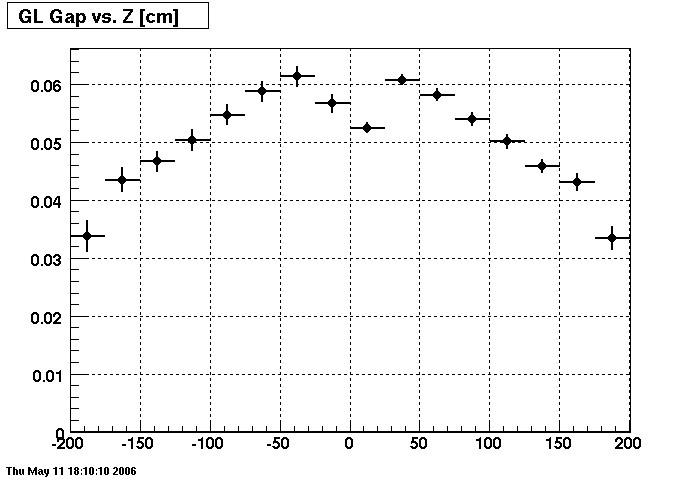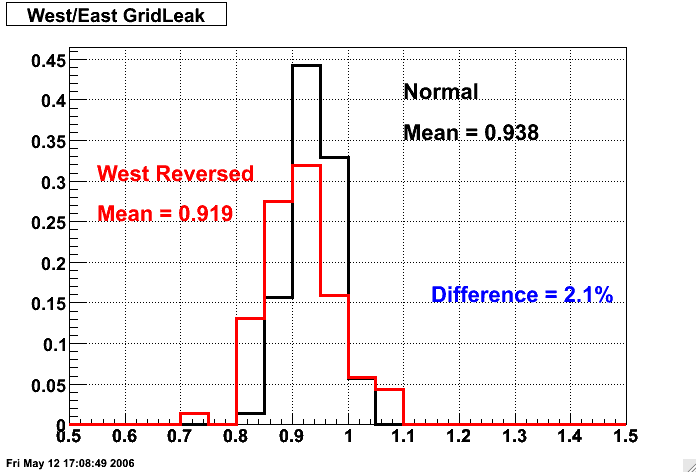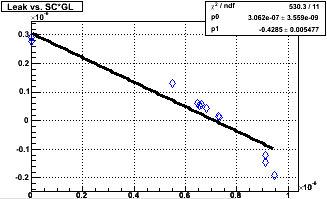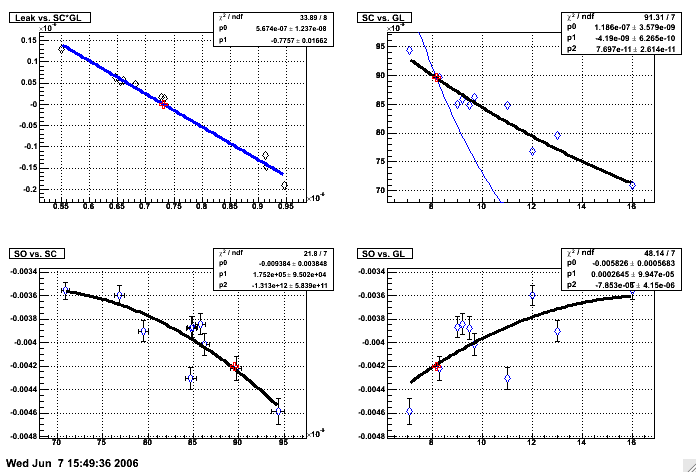pp200 (2006)
GatedGrid polarity test for GridLeak
On May 9-10, 2006, a test was performed where we reversed the polarity of the Gated Grid as shown in the top of Fig.3 in the GridLeak Simulations ["inverted" mode] for the west side of the TPC. Here are the results of that test.
Z-dependence
Below are plots of the distortion gap (as measured by track residuals) as a function of Z for normal runs (71290[234]*, 57 files) and test runs with the west GG reversed (71290[56]*, 39 files). Here one can see the slight improvement caused by reversing the polarity. At this time I have no explanation for why the distortion seems to abate near the central membrane (the distorting field should abate because of the boundary conditions, but the distortion is an integral in Z over this field).
Normal:
|
West reversed:
|
West/East Ratio
Using a linear fit to the distortion as a function of |Z| as a measure of the amount of leaked ions (distortion scales linearly with Z and with leaked current), I can take the ratio of the west side to east side to see if anything changed with the test. I find that the test appears to show a visible decrease of about 2-3% in the ion leakage, as seen in the following (normalized) histograms. I had more files available when I made this plot (70 normal, 69 reversed test files), and only fit over the range 25cm<|Z|<150cm.

Gene Van Buren
gene@bnl.gov
pp2006: longitudinal polarization
Using the calibration technique described SpaceCharge and GridLeak Calibration How-To Guide, I made several passes on data from the longitudinal polarization running. This was the first dataset from the 2006 running which I calibrated, and there were a few items to note during this calibration process:- No beamline constraint was yet available while I did the calibration. Instead, a beamline fixed to the z-axis was used. This should bias the vertex positions, but as long as tracks used in this calibration come from all azimuth angles, there should only be a smearing of the DCA distributions, not a bias.
- Distortions were larger than ever before, so histogram ranges needed expanding.
- Spread in the measures of the GridLeakage and SpaceCharge ionization were larger than I found when calibrating CuCu22 from last year, so I had to open the cuts used in the Calib_SC_GL.C macro (from 0.005 and 0.0003 respectively for CuCU22, to 0.015 and 0.0015 for this data). The SpaceCharge cut in particular had to be significantly widened. I though that this might be because of the uncalibrated beamline constraint, which introduces a smearing of a few mm into the primary vertex DCA distribution used to determine SpaceCharge, but a later test using the beamline constraint did not significantly narrow this distribution.
- For the first pass of this calibration, I used Fast Offline data which had no SpaceCharge and GridLeak corrections. While the first pass was somewhat useful to suggest where to start with SpaceCharge and GridLeak
correction parameters, I had to remove the first pass data points from the eventual iterative pass fits
because the distortion is so strong that without correction we actually lose tracks with large GridLeak gaps,
biasing our measure of the distortion. This can be seen in the following plot of measured distortion gap versus
the amount of GridLeak correction used (as expressed by SC*GL), where the no-correction points significantly
alter the straight-line fit:

It may also be true that the StMagUtilities code used to correlate distortions to the ionization has issues when the GridLeak gap is large. Work is in progress to improve this particular code.
Excluding the no-correction data, here are the plots and output from my final iterative pass (after enough iterations to stabilize the fits):
* Constraint on SC x GL = 7.31e-07
* Guesses on SC = 8.9e-08 , 3.95e-08 , 8.96e-08 , 3.95e-08
* Guesses on SO = 4.68e+04 , 4.72e+04
*** FINAL CALIBRATION VALUES: ***
SC = 8.96e-08 * ((zdce+zdcw) - (4.7e+04)) with GL = 8.2pp2006: transverse polarization
Just as was done in the pp2006: longitudinal polarization, I calibrated using the technique described SpaceCharge and GridLeak Calibration How-To Guide. Just a couple notes:- I did not even attempt to look at the no-calibration data as the pp2006: longitudinal polarization showed this to be of little help. I simply assumed that ZDC east+west would again be the best relevant scaler.
- Again, calibration was done without the beamline constraint with one exception. For the last pass, I used the values predicted by all the previous passes along with the beamline constraint. The result was a new data point which sits almost exactly on the fit curves, not changing the fits, which is good evidence that the fit had indeed converged.
- The fits for the offset parameter were not as good as the other fits, but almost certainly good enough to move forward.
- Spread in the measures of the SpaceCharge ionization did not improve in any significant way with the use of the beamline calibration. This implies that either the beamline calibration is not doing anything useful, or the spread in the sDCA distribution is dominated by something else.
Here are the plots and output from my final iterative pass:
* Constraint on SC x GL = 7.32e-07
* Guesses on SC = 8.73e-08 , 4.39e-08 , 8.63e-08 , 4.39e-08
* Guesses on GL = 8.39 , 11.3 , 8.48 , 11.3
* Guesses on SO = 3.27e+04 , 3.26e+04
*** FINAL CALIBRATION VALUES: ***
SC = 8.63e-08 * ((zdce+zdcw) - (3.27e+04)) with GL = 8.48
